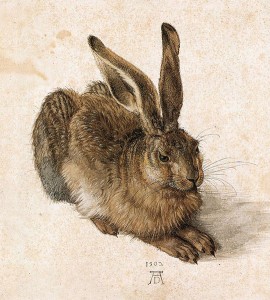
What? Professor Carol is writing about bunnies? Well, it’s mid-summer in Texas, and the mind does tend to bounce down strange pathways.
So let’s think about bunnies today. Not the bunnies embossed on Hallmark Cards or bedecked on shelves in the malls. I mean the real bunnies that hop around my particular neighborhood. (Yes, this is relevant to music and the arts, as I will explain.)
Back in our ranching decade, living in Bowie, Texas, I read about the very neighborhood to which we moved in late January. The headlines alternated between “Coyotes Roam North Plano” and “Bobcat Removed from Plano Neighborhood.” At the time, I thought: you’ve got to be kidding! You want critters? Come out to our ranch and I’ll show you critters. But it turns out, those headlines were correct.
Okay, some historical context. When I moved to Dallas at the end of 1984, Plano was a budding town 25 miles north of Dallas. It was J.R. Ewing’s Southfork Ranch, still separated by agricultural fields from its southern neighboring town of Richardson. There were open fields between Richardson and Dallas too.
Fast forward to today’s sleek, seamless cities of Dallas, Richardson, Plano. Only little green signs remind visitors that these were once separate places. Plano is as cosmopolitan as any city you’d find anywhere. But creeks still crisscross the landscaped developments. Big trees spread their boughs across the banks of those creeks. So the native coyotes and bobcats are still living there.
Not as many as in Bowie of course. Back there, every evening I could see the whites (or yellows) of their eyes from my back porch. As dusk turned to darkness, our Anatolian Shepherds started running the perimeter of our property in their all-night watch (better known as incessant barking). They were close to 100% successful. We lost a small dog and a couple of barn cats, but never a baby goat or calf.
While the Plano coyotes and bobcats snag a few urban pets occasionally, they primarily add a twist of personality to the area. The neighborhood website overflows with enthusiastic sightings. Residents seem to be rooting for them. Apparently, whenever the state Wildlife folks have worked to remove bobcats (in particular) from the neighborhoods here, the bunnies have taken over.
These aren’t like the brawny jack-rabbits racing down the Bowie dirt roads. They are cottontail bunnies, far cuter than the famous hare painted by Albrecht Dürer in 1502. They’ve hopped right out of a storybook and set to work eating the pristine suburban landscaping.
So what does this have to do with music and the arts? (No, I’m not about to explain the Bunny Hop.) We’ve started working on a new course. I won’t say much except to tell you that it’s focused on teaching the elements of Western music through the lens of Classical Education. It will cover significant concepts of theory and musical form.
Classical Education works like a complete ecological system. It combines the essential skills and body of knowledge that make us human and allow us to thrive. Music has always been an important component of a classical education. But lately it has come to be viewed as an add-on, not essential. Kind of like bunnies in suburbia.
But no matter how modern we think we have become, the classics always survive and reassert themselves. They remain relevant and vital. Suburbia doesn’t cancel out nature, and modern attitudes don’t alter what is essential to human nature. Maybe after living many years in the country where wildlife rules, it has become easier for me to see how that’s no less true in modern cities.
What a strange, interwoven ecological portrait this makes. A proliferation of natural predators and their prey, both seemingly incompatible with bustling urban life, yet living still amidst the flagstone walkways and trimmed flowerbeds.
I hope your mid-summer thoughts are bouncing along down interesting paths. And that the chance encounters that summertime allows will bring rest, joy, and new insights, whatever critters hop into your path.



